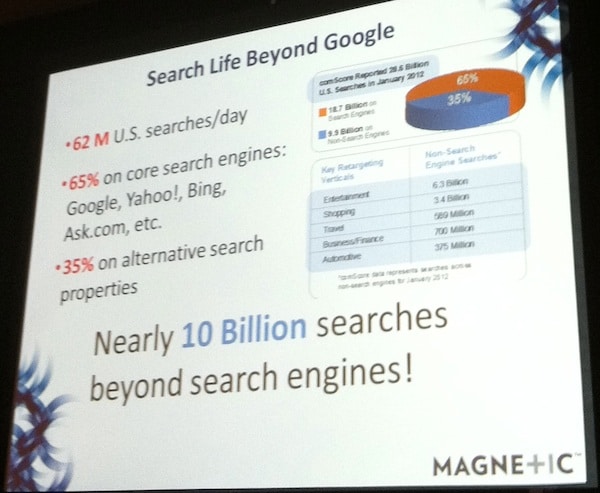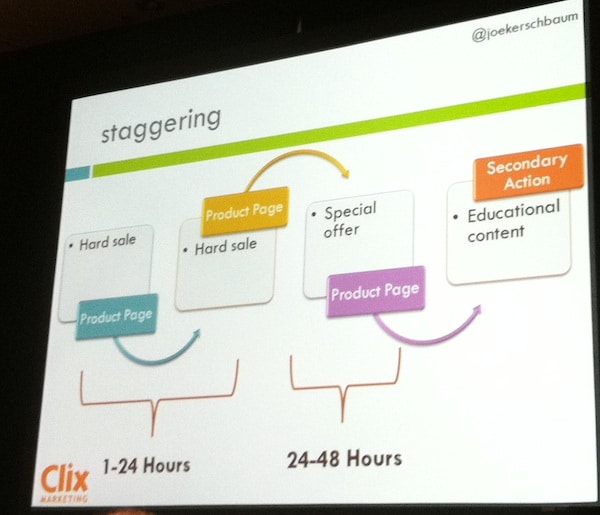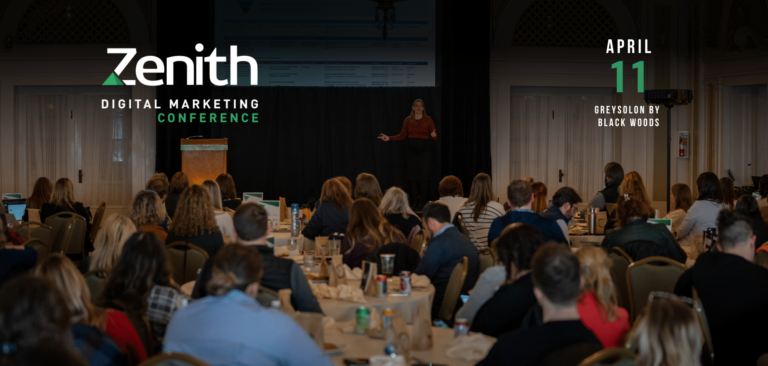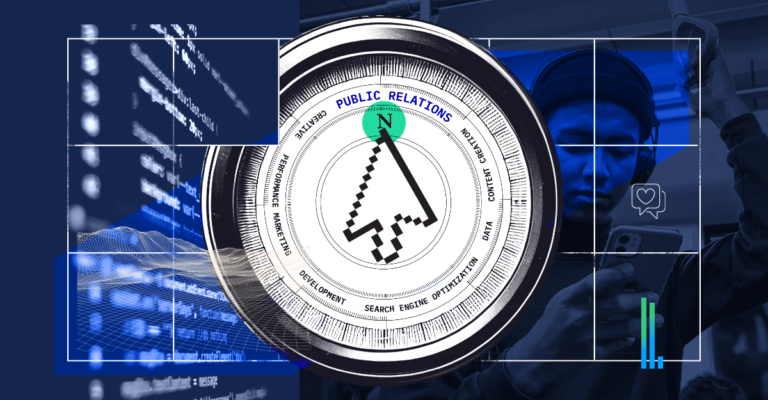Welcome back to AIMCLEAR‘s coverage of #SMX East 2012! Ahh, retargeting: A groovy little advertising option for cunning SEMs that walks the fine line between “talking” and “stalking,” now available in flavors of search and display! But hold up a tick – that fine line is fine indeed… bombard recent site visitors with a barrage of repetitive ads leading to repetitive hard-sell landing pages, and prepare for bitchy-backlash. A softer, more calculating touch is the sure way to win hearts and conversions. Yes, the key to not freaking out potential customers, but rather, reaching out to them in a meaningful, valuable way, is dependent upon your ability, as a marketer, to discern user intent and serve the right kind of ad to the right kind of person at the right time.
Sounds easy, huh? That was a joke. But achieving this retargeting trifecta need not be a mystery. For The Optimal Conversion Recipe: Search, Display, & Retargeting session, #SMX East 2012 brought together a panel of retargeting pros to share their tips and best practices for “making the most effective use of a rich combination of all types of marketing assets to extend their reach and boost conversions.” James Green, CEO, Magnetic, Joe Kerschbaum, Vice President, Clix Marketing, Kevin Ryan, CEO, Motivity Marketing, and Susan Waldes, Account Director, PPC Associates, led by moderator Pamela Parker, Contributing Editor, Search Engine Land, took turns on stage and dished up helpful hints, explanations, and actionable techniques with an audience eager to stalk talk with customers in a new way.
Once again, AIMCLEAR tried so hard to live-tweet this session, but unfortunately, the wifi in the Javits Center was utterly abismal. SMX did all it could, but many were without the precious resource for much of the day. But notes we did take. And a recap we did write. So go on, keep reading for the best goodies.
(BTW – in regards to the top photo in this post… yes, it is of a kitty-cat technically “stalking,” but it’s always 100% okay for kitties to stalk. Cause they’re so damn cute when they do it! But you— hey you, marketer— don’t you stalk. You’re not quite as cute.)
Pamela welcomed everyone back from the session break and introduced the speakers. “In this session,” she began, “we’re going to talk about the advent of retargeting and how the spread of it to more inventory has affected the job of search marketers. Online marketers have to do text and display. How do you do this best?”
Mmmm, quite. The question on all of our minds…
James was up first with a brief but poignant presentation entitled: Life Beyond Search Engine Marketing – How Search Data Drives Retargeting.
Coming from a background in display, James’s initial foray into search yielded the conclusion that… it looks a lot like display.
- action based market
- data-driven advertising
- bidding on KWs
Huh. Look at that. To that end, it’s interesting to note that search still has the majority of the total online advertising budget.
- Total online advertising budget = $1.3 billion
- Search = $14.4 billion
- Display = $12.3 billion
- What was your last search?
- Where did you initiate your search?
- What site did your search lead to?
- Did you search again? Probably. This time, more longtail (you’ve done research, you know more about specifically what you want.
The Intersection of Search & Display
So, the pattern goes like this:
initial search > consideration phase > revised search
What marketers can do now, perhaps better than ever, is use data to reach people when they’re in the middle – in the consideration phase (i.e. … considering what to buy, considering if they want to buy from you. People in this phase can be persuaded one way or the other, depending on your approach!)
If, in this phase, you swoop in like an angel of information and serve product research, reviews, and prices, perhaps you can win their hearts. James noted that the retargeting opportunity lies within 0-30 days of consideration period, whether that’s data is based on you own website, third-party data, social media, e-mail blasts, etc.
The Search Universe!
The universe of search is made up of many things beyond just search engines. There’s also…
- Shopping comparisons
- Vertical sites
- eCommerce sites
- There are 62 million US searches performed every day
- 65% of those searches are performed on core search engines
- 35% of those searches are performed on alternative search properties
That means there are nearly 10 BILLION searches performed on sites other than main search engines! In other words, Google controls about 43% of the market. That’s still a lot… but that still leave more than half!
James’s Ultimate Conversion Recipe
- Creative / contextual (branding & scale)
- Data-driven (precision & sales)
- Search (precision & conversions)
“It’s pretty hard today,” Jame concluded, “unless you’re a very small company, to not be pushed into buying display media based on this data. The ultimate conversion recipe should include this display-driven data.”
Words of wisdom. James handed the mic over to Joe, who was set to discuss why it’s important to think about retargeting as a conversation.
Remarketing is a Conversation
Hey, is there an echo in here? Okay, yes – remarketing is a sales tool. We use it to try to generate leads and sales. But we also have to think of it as a conversation with our core target audience. Our goal with retargeting is to create the right conversation with the right people. We can best achieve this by:
- Mixing and matching conversion actions (how you’re talking)
- Staggering ad delivery & messaging (what we’re talking about)
- Tightening your targeting (who we’re talking to)
But even this seemingly simple three-step strategy isn’t always easy peasy. Â Why? Because sometimes, people come to your site, and they just leave… without so much as a *sniff* buh-bye. Let’s explore that.
Why Don’t Customers Convert On Your Site?
Bleakly (albeit realistically), Joe noted that the reasons are “endless.” The truth is,  you may never know why they bounce.
- wrong time
- wrong place
- wrong action
- wrong copy
- wrong KW
- wrong price
- wrong product
…and that’s just a sample. There are so many reasons why someone won’t convert. The only reason you can’t help is if you’re just “wrong completely.” If you’re not what someone wants, that’s not your fault. But as far as the copy, KW, product, LP, etc. go – you can take definite measures to at least try and fix why they didn’t convert. Remarketing allows you to continue the conversation– because you already had the introduction! (They were already on your site, dummy!) So…Â in that middle area James referenced, between awareness/interest/consideration and purchase, that’s where you peek in and continue the chat.It’s Not Stalking… It’s Talking!
With retargeting, it’s essential to ditch the creepy lurking mentality, and remember – you’re there to have a conversation. How do you do that? Think about retargeting as a first date. If the first attempt to connect with someone totally backfires in your face…
A) Consider not trying again… and moving on to someone else. As Joe put it, “If we didn’t get you the first time, we probably won’t get you the second time…”
B) Consider switching up your approach. Don’t keep serving the same ad and leading to the same hard sell LP. You won’t get anywhere. That’s truly like saying the same thing over and over in a shoot-me-in-the-face boring conversation. Consider a softer touch (wink, wink).
Now’s the time to really think about your audience – try to identify what stopped them from converting. Can you address these issues with your remarketing?
Let’s head back to Joe’s three-step strategy.
Mix It Up!
Don’t be monotonous with the copy / ad / LP you serve. Shake things up. Consider implementing:
- longer sales copy
- shorter sales copy
- special offer
- softer sell
- more testimonials
- nurturing information
- other benefits
- different product
At the end of the day, only you know your business – rethink what you’re doing, and try something different.
Joe moved on to share a retargeting example of a client company that sells organic hair loss solutions / supplements. The client had some loss in sales as of late. Here are some possible reasons why:
- lesser known brand
- more expensive
- audience mostly conducting research (this is a sizable investment!)
- natural, organic product (questionable effectiveness)
The client came to Joe with a history of retargeting like so:
site visited > site abandoned > retargeting product ad served > leading to hard sell LP
…repeat, repeat, repeat. No wonder they weren’t getting anywhere.
Joe’s team proposed and implemented the following remarketing strategy:
site visited > site abandoned > retargeting ad offering informational whitepaper about hairloss in women served on a gender-neutral page > leading to LP where whitepaper can be downloaded > follow up with email marketing
Why was this more effective?
- Whitepaper wasn’t a hard sell
- Great offer, considering audience is typically in the information-gathering phase
- Demographic research obtained – people who downloaded whitepaper were most likely females, possibly older
- With new demo research, able to start serving more gender-specific ads
Nice.
Joe next lept into some ACTIONABLE THINGS TO DO NOW!
- define who you’re talking to
- brainstorm why you’re talking to them
- learn how you’re going to talk to them
- determine what to say to them, and when
Staggering Ad Delivery
“With remarketing,” Joe went on, “there is a window of opportunity, and a small window of relevency.”
Now is the time to consider your sales cycle.
- Your sales cycle is your window of opportunity.
- If your cycle is typically 7 days (you should know this based on info from Google Analytics), that’s your window.
- If your sales cycle is 30-60 days, that’s your window.
- If the window is 7 days, remarketing 45 days later is totally stupid and annoying and pointless.
- If the window is 60 days, don’t stop remarketing after 48 hours.
Also… keep in mind, despite what you may think, your relevance is finite. You are relevant to someone so long as they’re in the consideration phase, however long that may be.
No One Wins the Race to the Bottom!
Sure, special offers are great, but as Joe pointed out, you need to know your margin and ROI. If offering a secondary (free) conversion actions doesn’t work, don’t do it. Rethink what you’re doing.Think about how you can change the content you’re working on it. It’s not always feasible to win customers by giving away free things. It all depends on your business.
Oh, look! Some more ACTIONABLE THINGS TO DO NOW!
- Â Analyze sales cycle
- Map out relevance phase
- Determine engagement progression
- Utilize caried conversion actions
- Stagger campaigns as appropriate
Tighten your Target!
If you don’t want to retarget to everyone because you don’t want to hurt your budget, you should think about honing your campaigns. Don’t worry! You don’t have to retarget to everyone. No one will be upset. Seriously.
Joe recommended heading over to Placement Performance Reports in Google to learn more about the sites people visit after they visit your site. This information can help you determine who’s worth following, and who’s not.
- Loose remarketing = targeting everyone
- Tight remarketing = topic targeting
- Tightest remarketing = site targeting
Let’s return to the hair loss example. Okay… we only want to target people with our retargeting display ads who have visited our site, then gone onto visit a site about topics like “family” and” parenting” or “hair loss,” or they’re heading to the website, “drugs.com.”
You can identify all of these attributes when creating your retargeting campaign! Awesome. That means you won’t have to serve an ad to someone who gallops off to a completely unrelated-to-hair-loss website, where you can be pretty sure they’re no longer thinking about you or your product… because look, you followed them to an electronics website… and I bet they won’t want to be reminded of their thinning follicles while they shop for a new flatscreen TV…
OMG MORE ACTIONABLE THINGS TO DO!
- Review placement performance reports
- Determine plan to blend targeting methods
- Create messaging plan for carrying target
- Test, test, test
Alright! Joe wrapped up and Susan was up next.
Adwords Search Remarketing – the Agenda
- Intro to remarketing
- eCommerce use cases
- Exclusion uses
- Segmentation uses
- Attribution uses
Re-Engaging Search Marketing
Did you know…
- 96% of people who visit a site leave without completing the actions marketers want them to take
- 70% of people abandon shopping cart without completing a purchase
*Quiet weeping* no wonder retargeting was invented.
Susan pointed out that traditionally, it was all about remarketing by display. But now you retarget in search! Yippie!
eCommerce Use Cases… as told by Susan:
- eCommerce – Combine with dynamic search ads to reengage at scale.
- Use different messaging to people who have visited the site before to get customer to pull the trigger
- Promote new products / product lines to previous customers
- Re0engage during shopping events with special messages and broader KWs for people who have purchased from you before. (So smart!)
Exclusion Use Cases… great for those clients who often say:
- “Why would I pay for clicks on my brand KW?”
- “This $10k budget is for sourcing new customers only!”
- “I don’t want any duplicate leads!”
Segmentation Use Cases… which doesn’t have an afterthought like the other two above:
- Segment new (CPA on lifetime value) vs. existent (ROI on single transaction) users for different bidding
- Use different messaging / site links etc on new) vs. existing users or users who have completed the funnel steps
- Understand economics of visitors, converters, shopping cart abandoners, etc. and reinvest appropriately!
Kevin Ryan was up last but not least. Unfortunately, my laptop was completely running out of battery (serves me right for not getting there early enough for a seat up front), so read on for the ultimate gems and pearls from his presentation:
- Performance – agencies and constituents coalesce available marketing data. When you don’t define what your agencies and vendors are doing, they end up competing for business, but they should be working on your business. Define best practices and build knowledge base.
- Have a strategy. Focus on learning while earning. What works? What doesn’t?
- Prep for smart online media at scale – budget for testing and learning, and focus on intelligence gathering.
- Regarding targeting inputs– you have lots of targeting abilities. Be creative and thorough, but don’t abandon common sense. Select the correct targeting criteria for your targets.
- Three phase media process: 1 – identify the audience, learn about how they interact with media. 2 – property-specific executions. 3 – integrations and maintenance.
- By far one of the best takeaways: “Be prepared to try new things, but don’t go crazy.”
© sjallen – Fotolia.com











